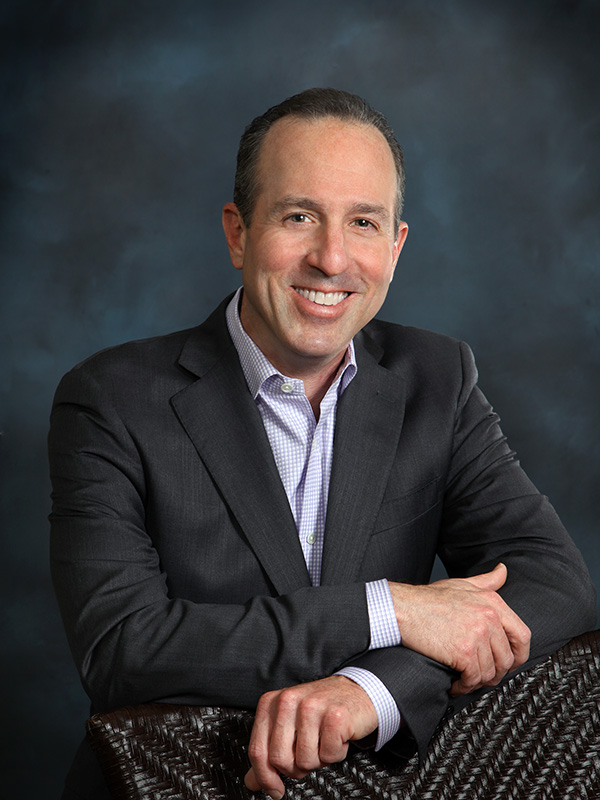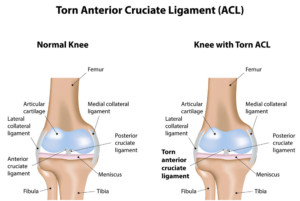ACL Tear Specialist

Are you an athlete who participates in sports that involve jumping or quick stopping? If so, you may be at risk of tearing your anterior cruciate ligament, or ACL. An ACL tear is one of the most common injuries suffered by athletes. ACL tear specialist, Dr. Mark Getelman provides diagnosis and both surgical and nonsurgical treatment options for patients in Los Angeles who have suffered a torn ACL. Contact Dr. Getelman’s team today!
Anterior Cruciate Ligament Tear (ACL Tear) Overview
The anterior cruciate ligament, commonly known as the ACL, is considered the central stabilizing ligament of the knee joint. The ACL runs through the knee from the front of the shin bone (tibia) to the back of the thigh bone (femur) and prevents the shin bone from pivoting or sliding out in front of the thigh bone. An anterior cruciate ligament injury is quite common in the athletic community and can range from a simple strain to a complete ACL tear. Dr. Mark Getelman, knee specialist in Greater Los Angeles with offices located in Thousand Oaks and Van Nuys, specializes in returning patients to the activities they love following an ACL injury.
An ACL injury generally occurs during athletic activities that involve sudden changes in direction or stops. Both of these movements cause the knee to buckle and shift. An ACL tear can also occur from a blow or direct hit to the knee joint. Athletes involved in football, basketball, volleyball and skiing have an elevated risk of injuring the ACL. ACL injuries are reported in more women than men.
ACL Injury Symptoms
An anterior cruciate ligament injury commonly causes knee pain, swelling and limited range of motion. The symptoms will vary based on injury severity. Patients that experience a mild ACL injury may notice mild to moderate pain and swelling, as well as slight joint instability. In more severe cases involving an ACL tear, patients may experience an actual “pop” at the time of injury followed by swelling and instability.
ACL Injury Diagnosis
Dr. Getelman will perform a physical examination during a patient’s first consultation to reach a diagnosis. During the exam, he will assess the injured knee’s pain level, swelling and range of motion. He will also order a series of X-rays and most frequently an MRI to assess the extent of the soft tissue injury and to confirm the diagnosis.
ACL Injury Treatment
Not all injuries to the ACL require surgery, but many will require a surgical intervention to return the knee to full function.
Non-Surgical
Certain cases of an anterior cruciate ligament injury can be treated with conservative measures such as ice, heat, rest, activity modification and elevation. Physical therapy may also be recommended to increase range of motion and strengthen the knee joint.
Surgical
Many patients who suffer an ACL tear require a surgical repair. He commonly recommends an arthroscopic ACL reconstruction for those who desire to return to cutting twisting and pivoting sports. This procedure replaces the torn ligament with a graft, either an autograft or cadaver allograft. Dr. Getelman will explain each graft option in great detail at a patient’s first consultation. While this is a common injury, it has been reported that most ACL reconstructions performed in the US are actually performed by surgeons who do less than 10 per year. Dr. Getelman in contrast typically performs apporximately 100 per year and is expert in primary reconstructions and ACL revision surgery as well. In fact, Dr Getelman may do more ACL’s annually than any other orthopedic surgeon in the Conejo and San Fernando Valleys.
For more information on an ACL injury or ACL tear, contact the orthopedic office of Dr. Mark Getelman, knee specialist serving Van Nuys, Westlake Village, Thousand Oaks and Los Angeles, California.
ACL Tear FAQ
What does an ACL tear feel like?
The pain from a tear of the anterior cruciate ligament (ACL), one of four main ligaments that maintain stability in the knee, is sudden and often severe, accompanied by a snap or audible pop when an injury happens. Often it the result of a twisting action (in a sport such as football, basketball, tennis or soccer), where the foot is planted on the ground and the knee is turned inward (also known as “plant and pivot”). The knee might buckle when weight is applied, or give out, causing the injured person to fall. Swelling may occur within a few hours of the injury, a result of torn blood vessels in the damaged ligaments bleeding into the knee joint. And it will very likely be too difficult and painful to do any activity, including walking.
Why do ACL Tears happen? How do ACL tears happen?
The most common cause is participating in sports, particular contact sports such as football, soccer, basketball, mixed martial arts, but also a recreational activity like downhill skiing. Any sport that combines planting the foot followed by a fast pivot or change in direction can lead to a tear of the ACL, as the knee is forcefully twisted or hyperextended. When an ACL injury occurs, the tears can be small or medium or more serious — a complete rupture, or tear, of the ligament, a separation of ligament from the upper or lower leg bone or a separation of the ligament and part of the bone from the rest of the bone. When this happens, the bone in the lower leg moves abnormally forward on the upper bone, which is what makes the knee seem to “give out” or buckle.
Are ACL tears common?
ACL tears are common and the answer as to why lies in our physical anatomy. In short, our bodies were not built to leap and “cut” from side to side. The force created by performing those movements stresses the ACL by pushing the tibia (the shinbone) out of position. The ACL’s main job is to prevent the tibia from moving in front of the femur and out of joint. It’s essentially a tough band of tissue that connects the two bones (tibia and femur) and helps stabilize and coordinate motion. If someone makes an awkward motion while planting his or her foot, the vulnerable ACL may be strained.
How does the ACL work?
An acronym for anterior cruciate ligament, the ACL serves several important roles, ultimately keeping the knee stable and functioning properly. It attaches the thigh bone (femur) to the shin bone (tibia) and keeps the shin bone from moving too far forward. It prevents excessive internal rotation of the shin bone and keeps the knee from hyperextending. When someone falls or lands a jump and makes a sudden change in running direction, the ACL can be sprained or torn.
Should I have ACL surgery after an injury?
If the knee is left untreated after an ACL injury, the knee may have ongoing problems with stability, in other words it may continue to buckle or give out particularly when engaged in sports that require pivoting (such as football, soccer and basketball). Initially treatment will focus on addressing the pain and swelling. When those subside and mobility improves, the person may walk more normally and might want to return to playing sports. If the ACL is completely torn, the ligament will not heal properly. Some people choose to live with a non-functioning ACL — one that may buckle or give out during certain physical activities, such as playing sports that require knee stability and lateral pivoting. There are also risks and complications associated with surgery.
The arguments in favor of having ACL reconstruction surgery:
- The ability to return to playing sports that require a fully functioning ACL
- The return to a stabilized knee
- It may offer protection from damage to the knee cartilage
When is ACL reconstruction surgery necessary?
A doctor may use the the Lachman’s test as one determinant of having ACL reconstruction surgery. While the patient lies flat, the doctor will bend the knee just slightly, at 15- to 20-degree angle. Next, the doctor stabilizes the thigh and pulls the shin forward. Between the shifting of the shin bone and the feel of the endpoint of movement, the doctor will learn how damaged the ACL is. Damaged ACLs may show more movement and less firm endpoint (the ligament may feel less solid or “soft”).
Doctors grade the results of the Lachman’s test on two criteria:
- The endpoint. If the endpoint is firm, that’s a sign that the ACL is limiting the amount of movement in the knee joint and is doing its job. A soft endpoint means that the ACL, and other secondary stabilizers, are not doing its job of limiting movement in the point. pivot-shift test.
- The amount of laxity (or movement) of the joint. That’s based on a comparison of the injured knee to the non-injured knee.
The measurements will determine if surgery is recommended.
Another widely used clinical test is the pivot-shift test, which tests for instability. It’s performed when the patient is relaxed, but reproducing that instability is unpleasant, it’s often done under general anesthesia. For this test, the patient lies flat with legs extended. While keeping internal rotation of the tibia (shin bone), the knee is slowly flexed to 25-30 degrees. The doctor will feel for a subluxation (or dislocation) of the lateral tibia as it moves back to normal position. The exam is conducted in three positions of rotation. If an anterior subluxation is felt during extension or tibia’s position on the femur reduces while the knee is flexed 30-40-degree, the ACL tests positive for instability and surgery will be recommended.
What is an ACL repair and when should I have it done?
ACL repair is a treatment for a complete ligament tear that results in instability of the knee. Instability can be determined by performing the pivot-shift test or Lachman’s test. A torn knee ligament may prevent a person from doing normal activities that involve turning or twisting the knee. The knee may also buckle or “give way. There is also a risk that not addressed surgically, another injury will occur or degeneration of other structures in the knee. A repair surgery in only done in cases where there is an avulsion fracture (which is a separation of the ACL and a piece of the bone from the rest of the bone). In this surgery, the bone fragment connected to the ACL is reattached to the bone. This type of injury is more common in children than in adults. For best outcome of an avulsion fracture, repair surgery is performed as soon as possible.
When can I run after ACL surgery?
Recovery from ACL surgery starts as soon as the patient wakes up from surgery. Walking without crutches should begin as you are able to tolerate bearing weight, usually within the first two weeks. Physical therapy will start with core strengthening exercises, eventually progressing to stationary bike riding. But be aware of pain and swelling as a sign of limits to your progress. Depending on the level of strength and balance achieved thus far, you may be able to start jogging for slow, short distances (avoiding hills) at the 4-6 month mark, with the focus of adding time each week. After nine months and, most importantly, clearance from your orthopedic surgeon, you may be able to run up hills and stairs to build leg strength. However, running down hills and stairs may be restricted, as it could irritate the knee or cause a tear in the meniscus (a crescent-shaped structure, made of cartilage, that helps distribute body weight across the three bones in the knee joint).

